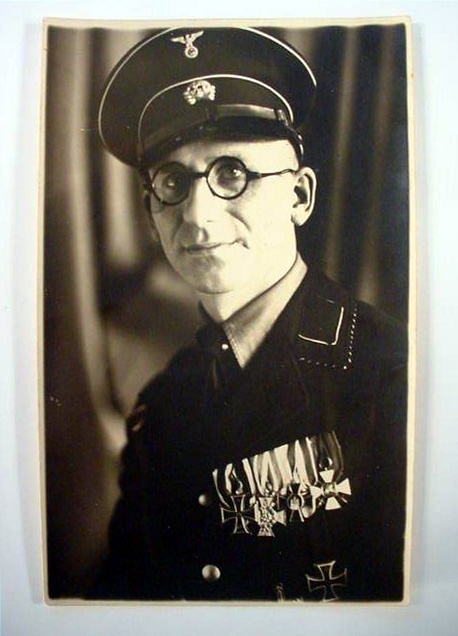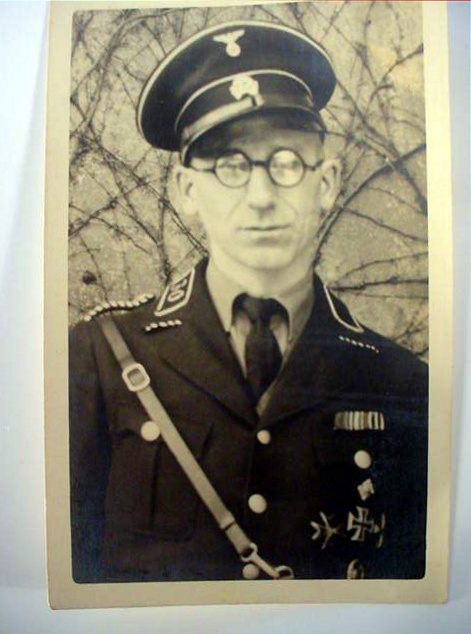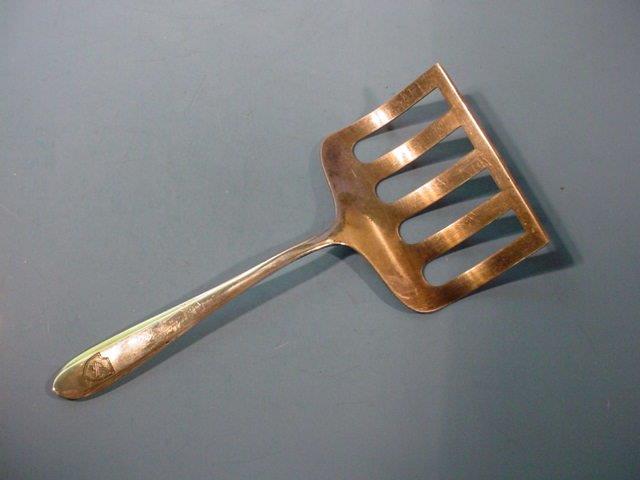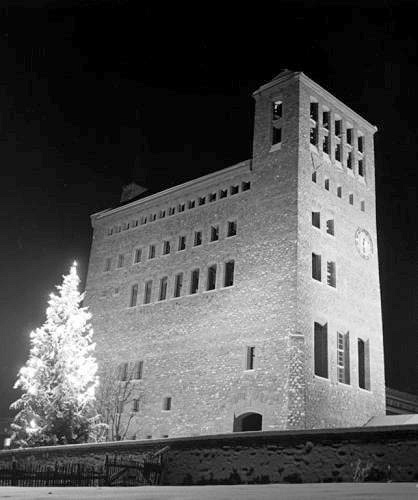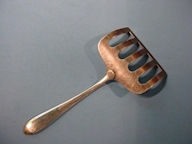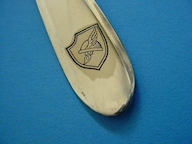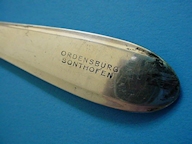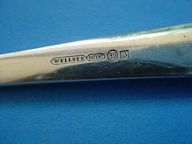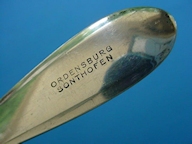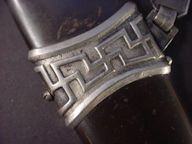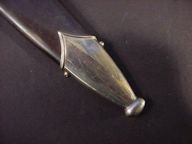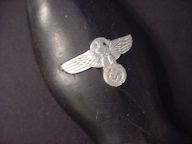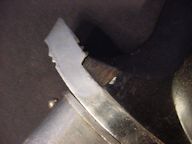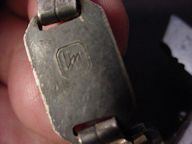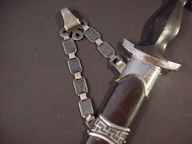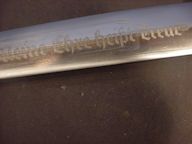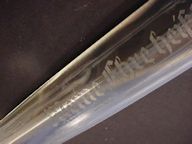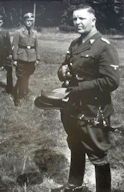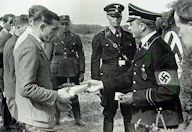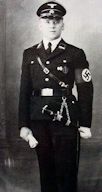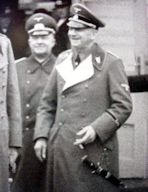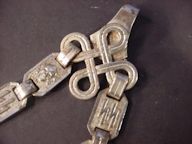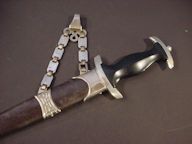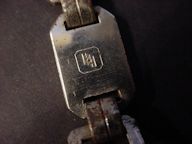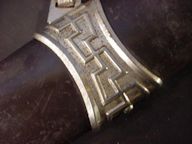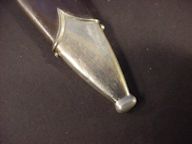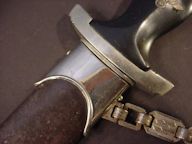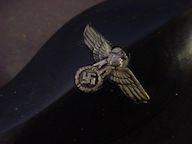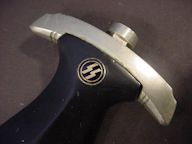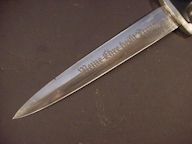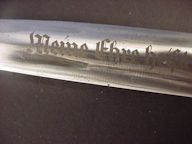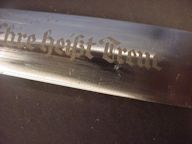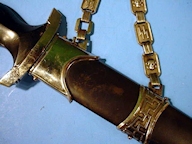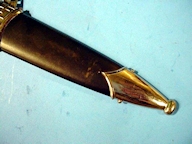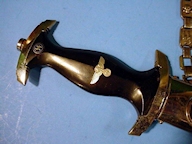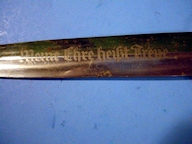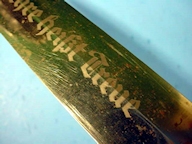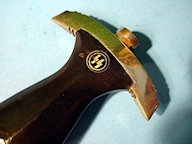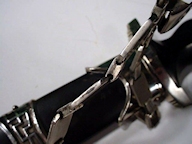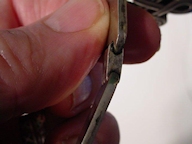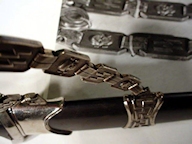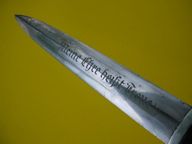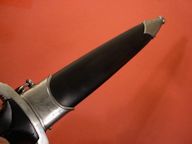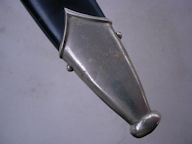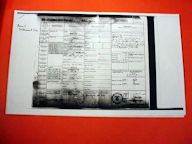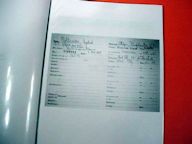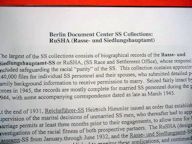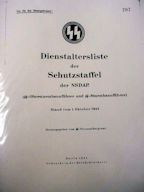|
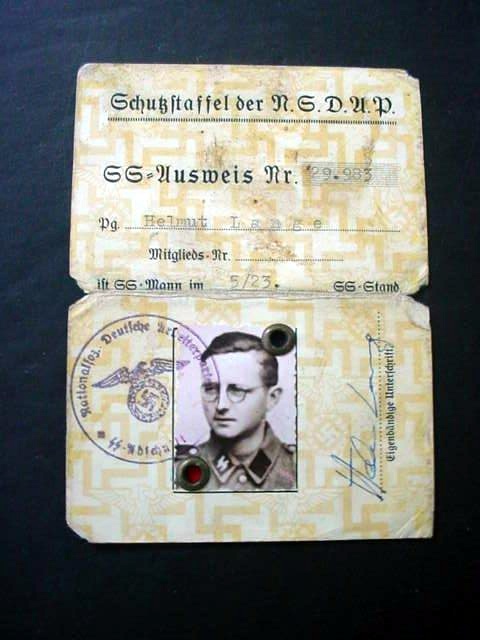
|
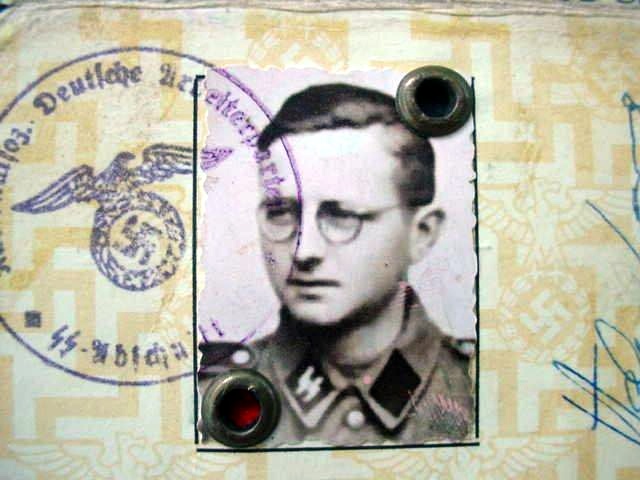
|
|
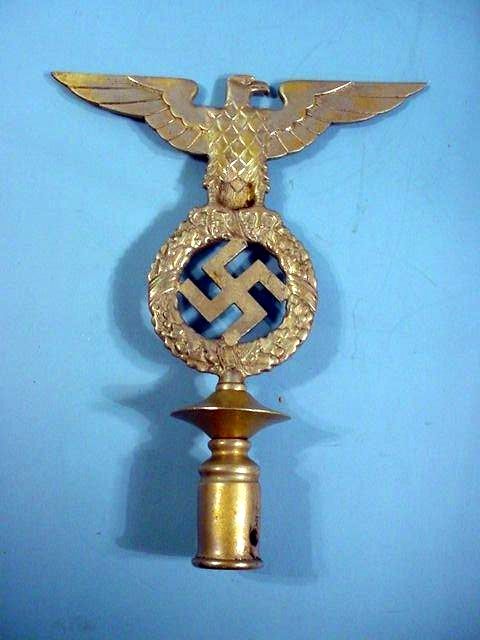
|
|
Early-Style NS Flagpole Top (Item SS 36-10; SA 14-20; NSDAP 18-41)
|
| DESCRIPTION: Here is a complete SA-SS flagpole top. To find one this complete is almost as hard to locate (and to some collectors, as desirable) as a Deutschland Erwache standard top. We have seen several of these with just the eagle and swastika portion with a threaded screw jutting out of the end and we have offered one or two of these in recent years, but this is the first complete one of these we have ever offered. When I say complete I mean with the barrel-shaped section with a saucer-shaped disc that the threaded screw goes into. The barrel is with the hole that the flagpole fits into and it has a hole in its side that takes a screw that holds the whole fixture firmly in place. The entire top is a little over 10 inches from the bottom of the barrel to the top of the head of the eagle. The wingspan is 8 inches. These flag finials were made of tough brass and are nickel plated. You can see a little bit of the brass showing here and there because this proud symbol was used in many of the parades in the Third Reich; both early SS and the SA Standarten used this style of eagle. It was also used by the political leader corps. This a rare and wonderful relic of the Reich.
PRICE: SOLD
|
|
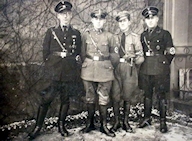
|

|
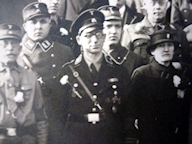
Close-up of image to left
|
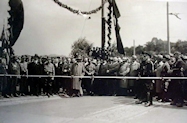
|
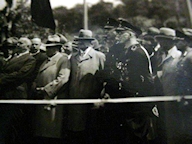
Close-up of image to left
|

|
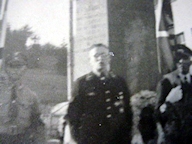
Close-up of previous image
|
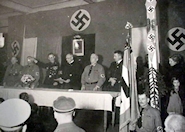
|
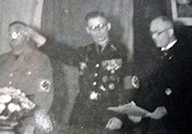
Close-up of image to left
|
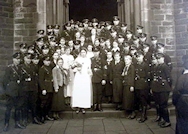
|
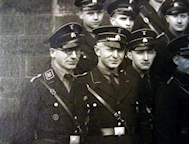
Close-up of image to left
|
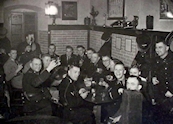
|
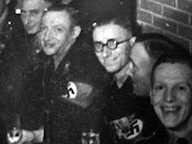
Close-up of previous image
|
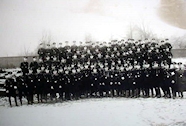
|
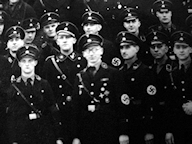
Close-up of image to left
|
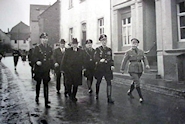
|
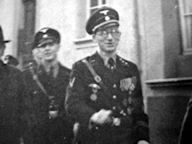
Close-up of image to left
|
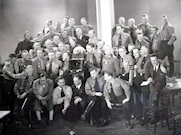
|
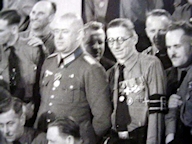
Close-up of previous image
|
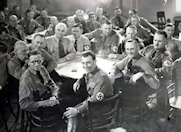
|
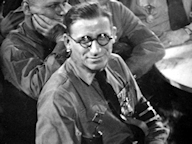
Close-up of image to left
|
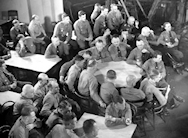
|
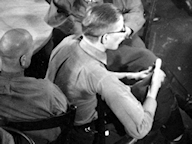
Close-up of image to left
|
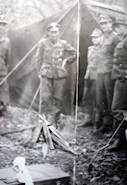
Now in the Waffen-SS
|
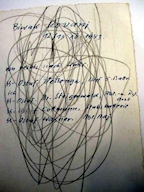
The writing on the back
of previous image
|
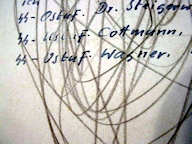
Close-up of Wagner's name and rank
|

Now in the Luftwaffe
|
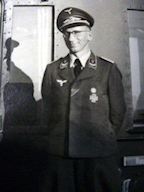
Close-up of image to left
|
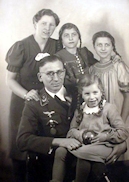
With family. Note the Blood Order
|
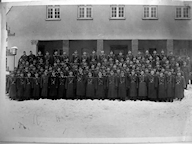
Group of Lufwaffe comrades
|
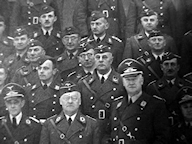
Close-up of previous image
|
|
Original Photographs of an  Winner of the Blood Order (Item SS 36-11) Winner of the Blood Order (Item SS 36-11)
|
DESCRIPTION: Here is a very rare group of 19 rare pictures all concerning a man who won the coveted N.S. Order of the Blood given to participants in the Putsch of 1923 in Munich on the 9th of November. Did he actually march with Adolf Hitler in that historic event? Was he one of the 1,500 original marchers? Or was he one of the people who served a time in prison for N.S. activities before 1933? Could he be one of the heroes, who received a death sentence, which was later commuted to life imprisonment, or had he been severely wounded in the service of the party? In rare cases it could also be bestowed upon certain persons considered to be national heroes of the Reich! The last recipient was Reinhard Heydrich (posthumously). One of two women who received this practically sacred medal was Eleonore Baur, better known as “Sister Pia.” She was the only woman known to have actually participated in the Putsch. The man who appears in these pictures is seen wearing the Blood Order in at least six of them. The pictures are great! One picture from his short service in the Waffen-SS has some writing on the back that shows that it was from a bivouac named Kovani somewhere in the Balkans in 1943. The picture identifies four officers and identifies the officers from right to left, and the fourth name so identified is “SS-Ostuf. (for SS-Obersturmführer) Wagner,” who was the company adjutant. We are sure this is our man. He is listed in the Dienstaltersliste der Schutzstaffel der NSDAP as being Horst Wagner having party number 90 008 with SS number 107 384. He was born 18.3.06. This would have made him 17 years old at the time of the Putsch in 1923. In 1.1.1944, Horst made SS-Standartenführer. At one point it appears he won the SS honor sword and the Totenkopf honor ring and was so privileged to be assigned to the headquarters of the Reichsführer, but in late 1944 or 1945 he joined the Luftwaffe. WHY? We would only be speculating if we were to even try to guess. Sometimes such happenings transpired when there was a conflict between an SS officer and Himmler; I guess we will never actually know. Our German picker bought these pictures from a family who was related to this man, but under no circumstances would they identify him or his family or for that matter even their own family name. Our picker was at a flea market on a Saturday afternoon near Nuremberg and he had a showcase set up and in it he had some Third Reich-era photos. He was approached by an elderly couple who asked if he would be interested in buying some more original pictures from the “Nazi time.” When he said he would they said they would be back the next day and they stayed true to their promise and on Sunday they returned with these precious photos. Our picker immediately made an offer and happily procured them. At that time he was told that they also had a ring that when described sounded like a Himmler Totenkopf honor ring. They also had an SS dagger, but would not sell them at this time. I suspect that the ring and possibly the dagger identify the man in the pictures and they definitely did not want to reveal this. I am using pure extrapolation here, but they did take our man’s phone number and said if they decided to sell the other items, they promised to call him. We can only hope at this point that this eventually will come to pass and maybe we will even find out something about the mystery of his transfer to the Luftwaffe.
The Pictures
Number 1: This is a 5 x 3 1/2-inch photo of the man featured on all the rest of the photos. He wears an enlisted rank’s Allgemeine-SS tunic and cap, but he has a very impressive bar of medals including the First and Second Class Iron Crosses, the Hamburg Cross of Honor, and two high orders that I’m not sure of.
Number 2: This is another similar picture, but with a numeral "30" on his collar tab.
Number 3: He appears once again posed with other uniformed NS personnel, one being an SA man. The next is a Hitler Youth lad and another SS enlisted man. This one says on the back "Weihnachten (Christmas) 1933."
Number 4: This is a photo of him with about 26 NSDAP members, SA storm troopers, political leaders, other SS men, and a woman (possibly his mother). They appear in front of an official building.
Number 5: This 5 ½ x 3 ½-inch image shows him with a large crowd watching a race at some kind of sporting event.
Number 6: The 5 ½ x 3 ½-inch image shows him as a keynote speaker at the unveiling of a stone eagle monument surrounded by uniformed SA men with flags.
Number 7: Now here is a 7 x 5-inch picture of him with arm raised in the “Heil Hitler salute” as he officiates at a meeting of the NSBO (NS leaders’ organization). He stands at the head table.
Number 8: In this 6 x 4 ½-inch image he’s seen at the far-left front at a wedding with many SS comrades and about a dozen ladies.
Number 9: Here’s a great 7 x 5-inch photo of a beer-hall assemblage of about 15 SS men and 1 SA man as they toast something or somebody (maybe the Führer?). Our man is central in the picture.
Number 10: This 8 ½ x 5-inch photograph portrays his entire SS-Abteilung (formation) out in the open. Our man is in the absolute center of the first row.
Number 11: This smaller 6 ½ x 4 ½-inch photo shows him with another Abteilung. He, again, is front and center. The picture is dated 13 January 1935.
Number 12: This 7 x 5-inch photo shows our man leading a group of important visitors along a row of buildings.
Numbers 13, 14, & 15: Here are the most important pictures of all! The three 7 x 5-inch photos are of a meeting of NSDAP Blood Order recipients. A furry dog lies atop a camera in the center of the scene where the men have lined up for their group photo. Interesting also is the fact that one of the members is attired in an army-officer’s uniform, and next to him is our man, Horst Wagner, now wearing a district leader’s armband. In another image, the men who participated are seated at a round table with their backs to us. They’re probably listening to a speech. In another picture eleven important “Blutorden Träger” sit in a pose for the camera with our man Wagner front and center-left.
Number 16: Now, for a short time, he is in the Waffen-SS and this 3 ¼ x 5-inch image is of a camp scene with four very interested soldiers listening to what he has to say. This is the picture with the handwritten names on the back identifying our man with “Ostuf. Wagner. Abt. Adj.”
Number 17: In this 5 ½ x 3 ½-inch image he is in the Luftwaffe as a captain (Hauptmann) standing by a train with two lieutenants. The door of the train says ‘Transport Officers.’
Number 18: This 4 ¼ x 6-inch photograph shows him with his family—wife and three daughters—when he was an Oberleutnant in the Luftwaffe. You can plainly see the Blood Order here on his uniform.
Number 19: This 9 ¼ x 6 ½-inch depicts a group photo of the entire Luftwaffe flyer group showing Wagner peering out in the third row above the commanding officer.
It is obvious that in all the pictures Wagner stands out in the front position. Besides being considered in the elite class by having won the Blood Order, his medals signify that he was a brave soldier in the First World War and some of the pictures indicated that he had some significant importance in the party, and the SS in particular. He never really acquired high rank for long it seems, but he certainly commanded high respect from his comrades. Then somehow he seems to have gone wrong! We would like to know more about him and if anyone could help in this we would certainly be most appreciative. This set of pictures is very rare because Blood Order recipients’ items are just never found or let go by the families. This is understandably so, not only because they are secretly proud of their memories, but because of the abject tyranny of the German government’s leftist leanings and that same government’s mean-spirited prejudice against anything coming forth that smacks of heroism or nobility during the era of the Third Reich. So, just imagine the rarity of this material! (It must be preserved!)
PRICE: $1,950.00; that is slightly more than $160 a picture and for something this prodigiously important, that is nothing!
|
|
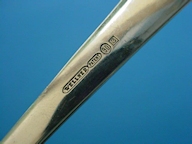
|
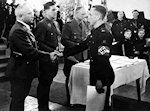
Graduation day at Sonthofen
|
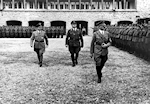
Hitler's reviewing students at Sonthofen
|

Ordensburg/Sonthofen
|
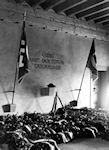
The Ehrenhalle at Sonthofen
|
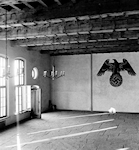
Interior room of the Ordensburg
|
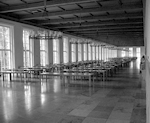
Mess hall at Ordensburg
|
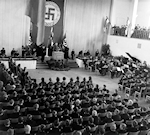
Graduation day at Sonthofen
|
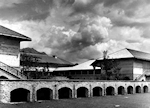
Ordensburg
|
|
Pancake Flipper for the  Nibelungen Division (Item SS 36-12; WAF 12-31) Nibelungen Division (Item SS 36-12; WAF 12-31)
|
|
DESCRIPTION: This division was formed in March 1945. The entire concept was born at Ordensburg Sonthofen. The idea was to form an elite SS division—even on the eve of the end of the war and ultimate surrender of Germany’s military powers. This group was to be “the elite of the elite.” It was originally meant to be quartered and trained at the Ordensburg Sonthofen, but because of later logistics they were transferred to the SS-Junkerschule Bad Tölz. This pancake flipper was one of the kitchen’s tools that were made by Wellner the company that made many of Adolf Hitler’s culinary utensils for the Reichs chancery and the Berghof. The pieces were delivered even at that late stage of the war to the Ordensburg. Many students at Sonthofen became recruits for the corps and when it changed to Bad Tölz many of the staff and students of that Junkerschule were happy to join. The division never consisted of more than 6,000 men. When the move transpired, the unit was given the title of the SS-Junkerschule Bad Tölz and then the 38th SS-Grenadier Division Nibelungen. This name was selected by the commander of the cadet school Richard Schulze-Kossens. The name Nibelungen comes from German mythology where in Wagner’s opera it was the name of a lineage of dwarfs. Certainly these stalwart soldiers of the Reich were no dwarfs, but the name had a certain Teutonic charm. Although they experienced only a couple of months as a fighting unit and I am sure they knew the war was lost they still showed bravery on the western front against the Americans. The utilitarian tool we offer has the divisional emblem engraved on it (the winged Wagnerian helmet). On the backside it has the name “Ordensburg Sonthofen” and the Wellner patent mark plus some identifying numerals. It is not silver; it is heavily silver plated and is about 9 inches long and the front blade is 4 inches wide and about 3 inches deep. This is indeed a rare relic from WWII and the struggle to preserve the Fatherland and in fact Europe in general. Meine Ehre heist Treue!
PRICE: SOLD
|
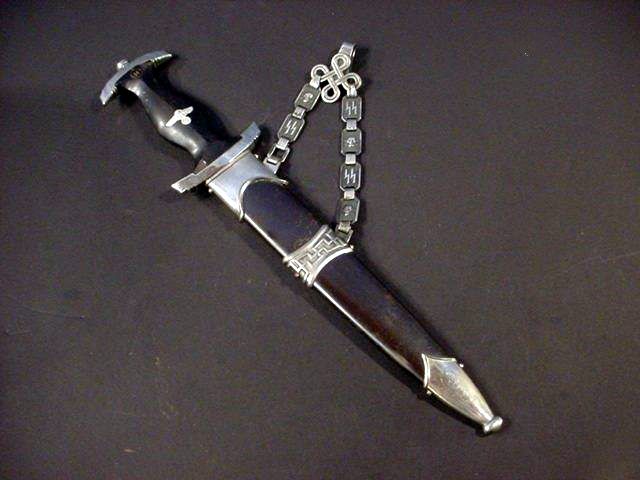
|
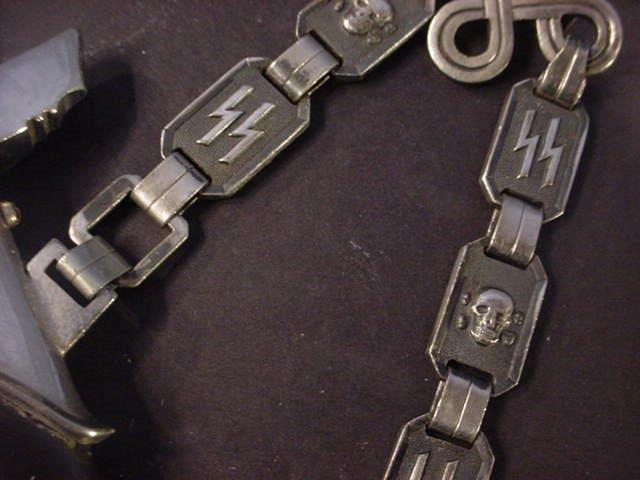
|
|
Model 1936 Chained SS Officer’s Dagger; Second Type with Anodized Scabbard (Item SS 36-13a; SSDAG 1-11)
|
|
DESCRIPTION: Here it is collectors; an affordable, nice example of the ultimate National Socialist item: the collector’s dream! What is more typical of the N.S. regime than this dagger? When the chained SS dagger is shown all eyes open wide! There is something about this art-deco masterpiece design that sets it far apart from all the other Third Reich weaponry. Some collectors are brought to thinking about “The Night of the Long Knives” when viewing one of these remarkable daggers. This of course was the scenario when Hitler settled the score with certain plotters who had decided to foment a counterrevolution and to liquidate the army command and this set the N.S. movement in turmoil and practically unseat the Führer. Anyway, others see the dagger as the whole denotation of the Reich, itself. The SS, of course was the power behind Hitler’s throne. Without them he could never have survived the assailments of the communists and reactionaries that were hell bent to destroy him and the National Socialist Party. The various configurations of the SS—the sharp, black uniforms, the skull and crossbones, the runic symbolism on collars, the armbands red with black side stripes—all went far to foment fear in its enemies and instill pride in its members. Then there were the adoring German masses who cheered in frenzy when the LAH (Leibstandarte Adolf Hitler) bodyguard regiment goose-stepped by in concise procession. No elite unit in the world ever enjoyed such a nationwide admiration and so it was that these marvelous daggers—first introduced in 1933 (the model without chains)—were presented during a somber ceremony at the famed Feldherrnhalle in Munich. This mysticism-charged annual ritual was meant to summon up memories of the medieval Teutonic knights and the days of past glories. When 1936 came around there was an additional feature added to the dagger that made it all the more regal and beautiful. It was introduced in late 1936 and was the new chain hanger for new and existing officers. This later produced dagger was similar to the 1933 model but with a central mount fitting decorated with swastikas and a pebbled background that is attached to a chained suspension hanger with octagonal links that feature leering skulls that alternate with other links that show the double-runic symbol of the SS. This chain was designed by Professor Karl Diebitsch and the links had two meanings: the first is the skull and crossbones to signify loyalty unto death; the other is the two sig runes that signify the power of good over evil that sparks from the hammer of Thor. The chains suspension clip was embossed with an ancient Teutonic motif called “Wotan’s Knot.” The reverse of one of the links was stamped with two intertwined sig runes. This is the Kulterabzeichen that honored the designer SS-Obersturmbannführer Karl Diebitsch, who, by the way was the designer of the original SS black uniform and founded the SS-Allach porcelain manufactory. There are two styles of the chains and the type one was basically like onto type two even with the same center band, but has a “DRGM”-marked clip that can be seen under the Wotan Knot. The type-two chain has the dark burnishing on the links and the center band, and the Wotan Knot is solid and not open. Two connector rings are angled to fit more artistically into the knot. This was actually a scheduled improvement. The dagger we offer here is a type-two model. There was another great improvement designed by Prof. Diebitsch, but never put into production, unfortunately, and Germania International actually has the one, and only one, ever found. Please go to Item SS 36-14 or Item SSDAG 1-10. This is the rarest SS chained dagger in existence and (well worth looking at!). The dagger we offer here, however, is a completely fine, textbook example being in very collectable condition having everything that the collectors desire to see. The crossguards and tang nut are the early nickel type. These crossguards are in choice condition having smooth surfaces, crisp edges, and precise accent grooves. Looking at the tang nut it does not appear to have been removed in many years. The grip is a very fine example, but it has two small chunks of the wood missing where the grip meets the crossguard on the right side front and rear side back, and there is some minute damage to the ebony grip at the area in the back of where the runic button is at the top. The rune button is placed with nearly a straight up-and-down position. The grip eagle is bright. The details are all there at the bird’s head, breast and wing feathering, talons, wreath, and mobile swastika. The ebony grip fits nicely into the crossguards even though we have that slight damage and there are some spaces between the places where the grip should bank up against the metal of the crossguard blade shoulders. All of this simply comes about with age in wood pieces and it also has much to do with wherever the dagger was stored in the last 75 or 80 years (dry, good; wet, not so good!). The scabbard is the anodized style in its finish. Its great patina is in wonderful condition and still has all of its original luster which places this magnificent dagger in the late 1930s. There is great patina on the scabbard center band as well as the links. The original background darkening is still in place. All the links have 100 percent of the darkening. The skull-and-bones links are in very crisp condition; each one showing all the leering teeth. The rune links are also exceptional. The unmarked blade is an outstanding example having all the original grain and a good, needlelike tip. The blade also has the typical light etched motto, and this motto still has all the original darkening in the background, and other than the usual (in and out marks), the blade is in practically mint condition. This is an extremely nice initial-production SS dagger showing some honest usage of the period, but remains in highly desirable condition. This is a really great example to add to your collection. They say that if you don’t have a chained model SS dagger, you really do not have a Third Reich collection at all! Yes, this one has some problems, but its rarity and general condition more than make up for it in our well-considered opinion.
PRICE: SOLD
|
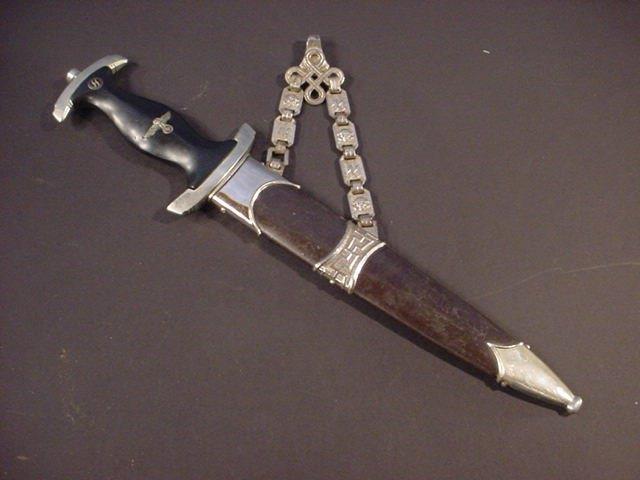
|
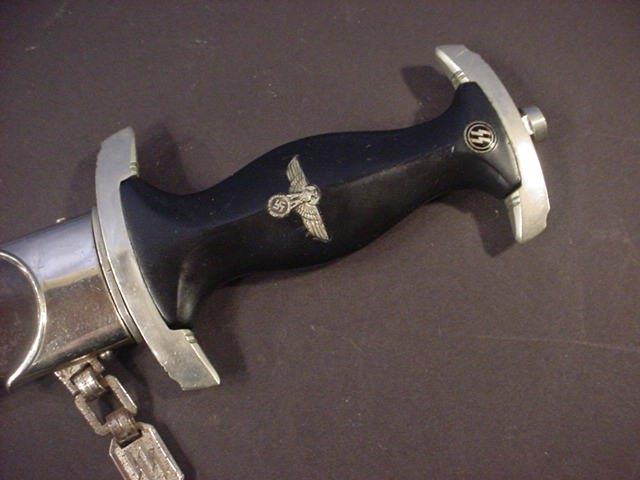
|
|
Chained Model 1936  Officer’s Dagger (Item SS 36-13b; SSDAG 1-12) Officer’s Dagger (Item SS 36-13b; SSDAG 1-12)
|
|
DESCRIPTION: Here is another good specimen of the famed SS officer’s 1936-model dagger similar to the one in the above section. This one also has the very desirable anodized scabbard. The grip is in ebony and the fit to the crossguards is perfect, except for some of the wood at the top. The top and bottom guards are in genuine nickel while the scabbard throat and center band are nickel plated. The crossguards, the skulls, and runic symbols on the links are clearly depicted, but a very small bit of corrosion has set into a link or two. Remember, this is a 100-percent-original dagger of a type that is fast disappearing from the collectable scene. Other than that the dagger is a very fine example with all fittings: sharp including the teeth of the skulls (important in these weapons). The grip eagle and runic enamel and runic bottom are sharp with super detailing to the eagle. The etched blade motto is clear with all its darkened patina intact. There are a couple of marks at the blade point where it meets the bottom crossguard and one tiny mark on each side of the edges almost down to the tip, but still the blade grades excellent, at least. The links and crossguards do not have the darkening that some manufacturers produced, but are bright and with high luster. This is a highly collectible SS dagger and its problems are minute to say the least, but it is better than most that have been offered out there in cyberland. Daggers in similar condition have sold for $10,000 or more; however, we offer it an incredible, special price.
PRICE: SOLD
|
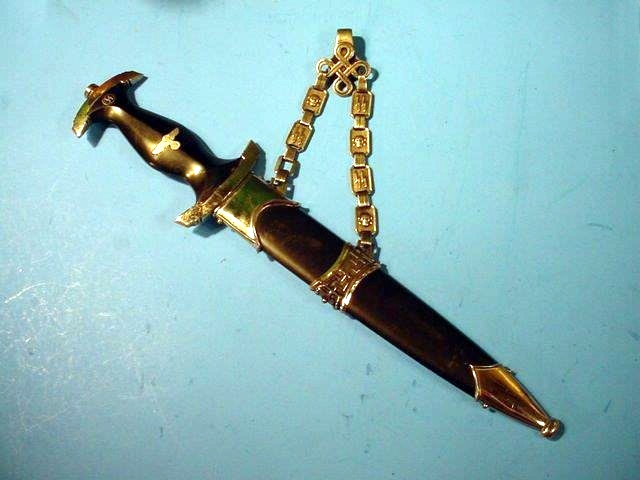
The dagger with prototype chain
|
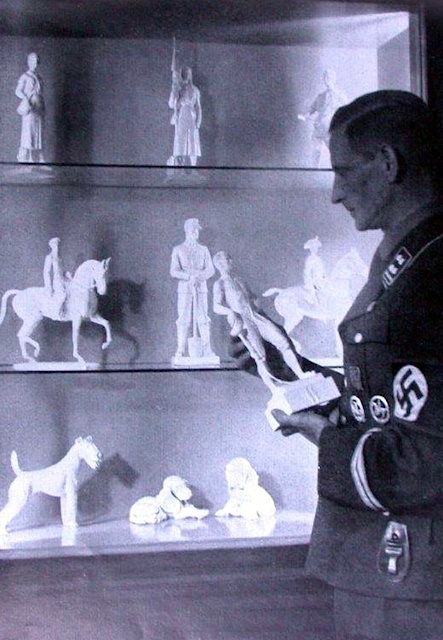
Professor Carl Diebitsch in the  -Allach showroom in Berlin 1939 -Allach showroom in Berlin 1939
|
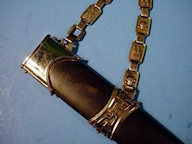
|
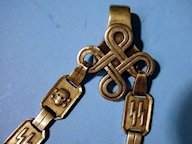
|
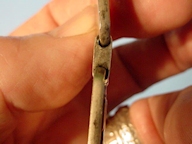
The special attachments
|
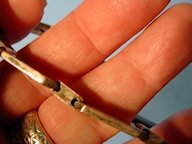
How is it done?
|
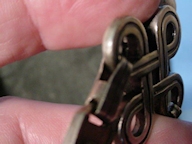
|
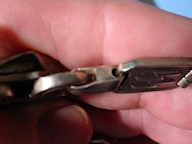
|
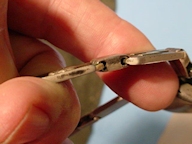
|
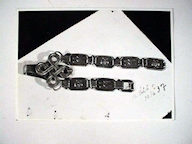
Exhibit #1 with date 30/6/37
|

|
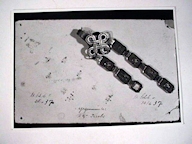
|

|
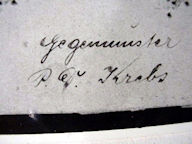
|
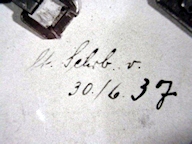
|
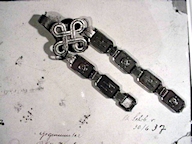
|
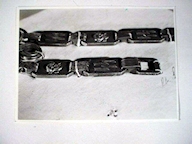
|
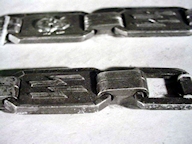
A good view of the connectors
|
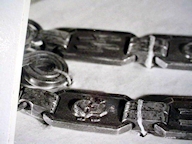
|
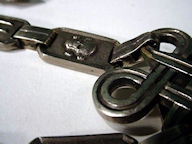
|
|
Ultimate (Prototype) SS Chained Officer’s Dagger (Item SS 36-14; SSDAG 1-10)
|
DESCRIPTION: Are you one of the elite collectors who might have considered owning the absolute ultimate in a dagger that already is and always has been the absolute most popular and beautiful N.S. dagger that the Third Reich ever produced? OK, it is not as pretty as an SA high-leader’s dagger, or Hermann Göring’s wedding sword, or any of the very special pieces sold by the other “big names” in the military field, but the piece we offer here is as important and possibly more important than any of them, at least in my way of thinking. This is Carl Diebitsch's 1940s model SS-officers dagger with prototype chain. This dagger is actually a late specimen, but it still would be a 1936 model with some minor differences. It is no doubt unique! We have never heard of another one that has ever turned up and we seriously believe that this is the only one that you and I will ever see. In about 1982, I went to the district of Tegernsee in Bavaria along with Dr. Edward Rich, a brilliant historian and author with purpose of visiting Professor and ex- -Oberführer Carl Diebitsch. We interviewed him on myriad subjects, but especially about several articles that were reportedly designed by him. The first and foremost was a tapestry that once had been a decoration in the offices of the SS-Ahnenerbe Stiftung in Berlin. We owned a fantastic tapestry at that time and it is shown in the book Pictorial History of the SS: 1923-1945 by Andrew Mollo. The tapestry was designed by Prof. Diebitsch and woven by his sister Elsie Seifert. I also showed him a card with pictures of two chain assemblages that purportedly had been once in his possession. One of the chains was missing from the picture and the other one was still in the picture, but we did not know the whereabouts of the one that was in the picture, either. A dealer in Buffalo, New York, claims he sold it years ago and didn’t remember who bought it. I still have the picture of the card along with two more pictures of the chain along with little notes on that card that were made by the hand of Prof. Diebitsch. Now! Why is this 1936 dagger so very different from others??? I ask you to look very carefully at the pictures of the chain attachment shown on the card and especially the fastening devices that connect the alternating skull links to the links with the -Oberführer Carl Diebitsch. We interviewed him on myriad subjects, but especially about several articles that were reportedly designed by him. The first and foremost was a tapestry that once had been a decoration in the offices of the SS-Ahnenerbe Stiftung in Berlin. We owned a fantastic tapestry at that time and it is shown in the book Pictorial History of the SS: 1923-1945 by Andrew Mollo. The tapestry was designed by Prof. Diebitsch and woven by his sister Elsie Seifert. I also showed him a card with pictures of two chain assemblages that purportedly had been once in his possession. One of the chains was missing from the picture and the other one was still in the picture, but we did not know the whereabouts of the one that was in the picture, either. A dealer in Buffalo, New York, claims he sold it years ago and didn’t remember who bought it. I still have the picture of the card along with two more pictures of the chain along with little notes on that card that were made by the hand of Prof. Diebitsch. Now! Why is this 1936 dagger so very different from others??? I ask you to look very carefully at the pictures of the chain attachment shown on the card and especially the fastening devices that connect the alternating skull links to the links with the  runes. If you are familiar with the standard fastening devices you will know that those pieces are the only item that make these magnificently designed daggers less than perfect. The attachments adopted in 1936 are not only ugly, but they have been known to come apart if the pressure of the officer’s hand bore down on the dagger while wearing it. Professor Diebitsch was the actual designer of the 1936 model dagger and the SS sword and accomplished many other artistic designs within the SS, plus official postage stamps of the Reich. He was a highly accomplished painter having received one of the top prizes for his painting titled Mutter (“Mother”). He was the designer for the Ahenenerbe letterhead with the sacred Saxon Irminsul. He was the director and founder of the SS porcelain manufacturer Allach, and many of the designs were executed by him . He designed many of the tapestries that his sister produced. We have the great tapestry with the swastika motif that was removed from the Berchtesgaden Reich’s Chancellery and then was removed to Heinrich Himmler’s home after a fire in that chancellery. So, Diebitsch was certainly one of the major artists of particular note in the Third Reich and I have been honored and proud to have met him and his sister Elsie Seifert. runes. If you are familiar with the standard fastening devices you will know that those pieces are the only item that make these magnificently designed daggers less than perfect. The attachments adopted in 1936 are not only ugly, but they have been known to come apart if the pressure of the officer’s hand bore down on the dagger while wearing it. Professor Diebitsch was the actual designer of the 1936 model dagger and the SS sword and accomplished many other artistic designs within the SS, plus official postage stamps of the Reich. He was a highly accomplished painter having received one of the top prizes for his painting titled Mutter (“Mother”). He was the designer for the Ahenenerbe letterhead with the sacred Saxon Irminsul. He was the director and founder of the SS porcelain manufacturer Allach, and many of the designs were executed by him . He designed many of the tapestries that his sister produced. We have the great tapestry with the swastika motif that was removed from the Berchtesgaden Reich’s Chancellery and then was removed to Heinrich Himmler’s home after a fire in that chancellery. So, Diebitsch was certainly one of the major artists of particular note in the Third Reich and I have been honored and proud to have met him and his sister Elsie Seifert.
Back to the dagger chain
You have seen the inferior link fasteners on the regular 1936 Mod SS daggers and it must be admitted that this probably is the only weakness of the first model 1936 dagger’s design and construction.
The Prototype
I distinctly remember that when I handed the picture to the professor he was quite surprised and immediately stated, “I ‘m absolutely amazed! I never thought to ever see this again.” He then said that these are pictures of the design change that he hoped could be accomplished and he sent suggestions to Himmler in 1937 suggesting that the link construction should be changed and that when he originally designed the dagger the links should have been joined with his special connectors and he pointed out in our pictures that this was his design and the notes on the cards were his and were sent in this manner with two finished chains to Himmler’s office. Unfortunately, the SS procurement office never adopted the superior design to his great disappointment and they sent the card with the chains back to him with a note saying the Reichsführer-SS said it was a wonderful design, but he felt it was too late to change the production. The professor also told us that he had finished such a chain and attached it to a dagger, rather later in the 1940s, but the dagger was looted from his office at Dachau at the end of the war where the porcelain was produced. I remember that we did not ask if there were more of the daggers with the special chain. It must have slipped our minds, but then he had only mentioned one so we assumed that there was indeed only one. We did speculate at the time that somewhere out there was a dagger with that wonderful special chain or we assumed there was, but we were quite sure we would never see it. But, amazingly, in 1995, I was making a deal on several Third Reich articles with another dealer and at one point I was totally shocked to observe that one of two model 1940s chained SS daggers that I was seeking to acquire had the special Diebitsch links. I was stunned! But the dealer never noticed the difference and when I pointed it out to him he was totally indifferent. I completed the deal and was thrilled to take this treasured relic home with me and that is where it has been ever since. I think it nothing short of miraculous that I turned up this treasure, but it was not the only miraculous find of my past career, I have been very fortunate in locating many fabulous treasures of the Third Reich.
The Unique Design
Now look closely at the image marked “Exhibit #1” and see the connecting fasteners that tie the links together. It is almost impossible to discern how they are constructed, but one can readily see that they would be much more applicable with strength to hold—and hold firm (Putting to shame the ones that were approved and adopted). Then look at the actual links on the dagger that we show and you will realize if you are a true connoisseur of these things that here would be the zenith of design perfection as Carl Diebitsch had envisioned it. At first look, it’s practically impossible to even speculate as to how these pieces even manage to attach (they are so intricate). So, here in all its “black glory” is the Carl Diebitsch prototype dagger. It is certainly unique and, of course, most probably the rarest SS dagger in existence.
No longer available.
|
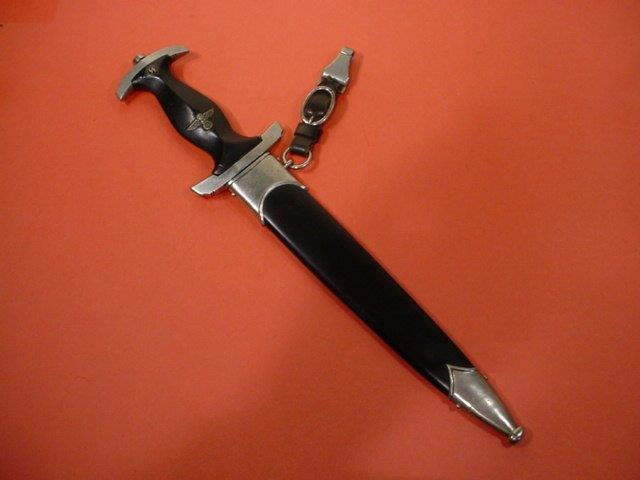
|
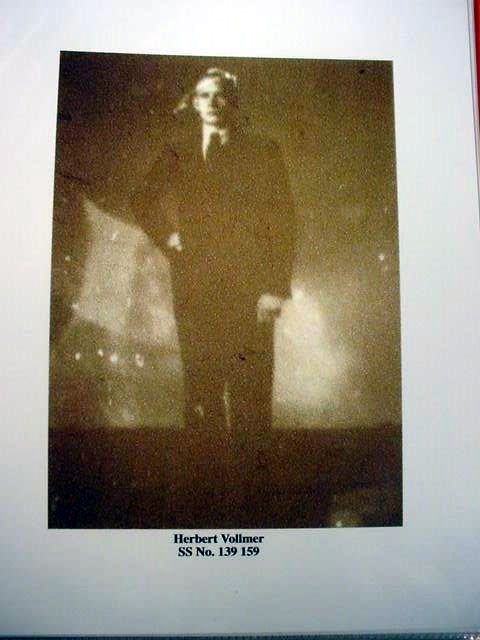
Image of Vollmer
|
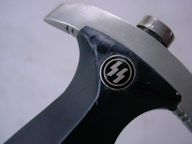
|
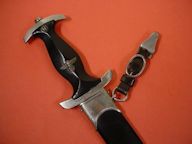
The carrying strap
|
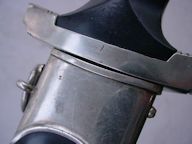
Section I (Munich) from where
the dagger originates
|
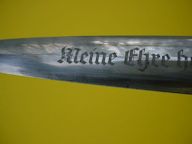
|
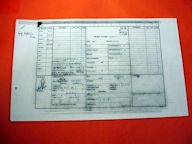
Part of Vollmer's records
|
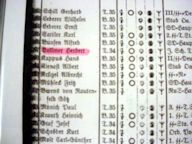
|
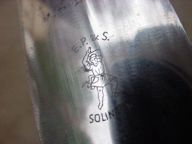
|

Allgemeine-SS
|

Allgemeine-SS troopers
|
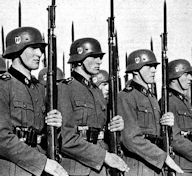
Waffen-SS troops
|
|
1933 Model  Dagger from an Officer of the Allgemeine- Dagger from an Officer of the Allgemeine- and Waffen- and Waffen- (Item SS 36-14a; SSDAG 1-13) (Item SS 36-14a; SSDAG 1-13)
|
DESCRIPTION: Herbert Peter Vollmer was an SS-Sturmbannführer of the 5th SS-Freiwilligen Gebirgsjäger Korps (Mountain Troops). At one point he was one of the commanders of the SS Freiwilligen-Grenadier Division 87 “Falke”. But in the October 1944 edition of Dienstalterliste der Schutzstaffel der NSDAP we see him listed as being in the aforementioned SS-Gebirgsjäger Korps with the N.S. Party Membership Number 4 166 993 and with the SS Membership Number of 139 159 and this number is found engraved upon the underside of the dagger’s crossguard. Also shown in symbols is the fact that Vollmer had received the SS Honor Sword and the Honor Ring (Ehrenringe of the SS). It indicates that he was made Sturmbannführer on 18 October 1942. He also won the Iron Cross First Class, the Close Combat Badge, and the Wound Badge. He was born October 29, 1913. Other records indicate that he won the German Cross (Deutsches Kreutz in gold). In other words: here was a hero of the Reich!, part of that elite group of men who curtailed Joseph Stalin’s methodic and systematic plans to conquer Europe and spread the communist poison from the Elbe to the coast of France. It was only the young Teutonic warriors of Germany’s Operation Barbarosa that stopped the horrible tragedy from happening. They laid down their lives; four million of them died in the cause of freedom and for their sacred European homelands. The dagger we have is from Herbert Vollmer’s Kampfzeit period (Time of Struggle—1928 to 1933) when he was considered one of the loyal guardians of the N.S. Party and the Führer Adolf Hitler. These SS men were usually the crème de la crème of manhood: well educated, physically superior, and of strong virtue, quite different than the Red Front hooligans that they fought against so effectively. They, on the other hand, were the noblesse aristocracy of the National Socialist movement—the epitome of German manhood! The dagger is in extra-fine condition with minute cracks in the grip noticeable only on extremely close inspection or magnification. The scabbard finish is so fine that it’s hard to tell if it is painted or anodized. The fittings at the top guard and bottom crossguard meet with the wood with no gap whatsoever. The elongated ball at the tip of the scabbard is in perfect shape. So many are squashed from dropping on the ground, as so often happened. The blade is by E. Pack and Sonne in Solingen and it has the logo showing the legendry Wagnerian hero Siegfried forging his sword “Nothung.” The blade is in wonderful condition showing only the “in and out marks,” but it grades overall about excellent plus. The SS motto Meine Ehre heisst Treue is there with 100 percent of the original factory darkening in the backgrounds of the letters. On the back of the crossguard you will see the Roman numeral I and this stands for the SS-Abschnitt or district that the dagger was sent from. The ‘I’ is from district Munich. This 1933 model Schutzstaffel dagger also has the rarely found or included short hanger with retainer loop with the original company markings. Now the most important feature is the fact that as we previously mentioned SS-Sturmbannführer Vollmer’s SS identification number 139 159 is engraved underneath the crossguard. This numbering was not required by the SS leadership committees, but certain officers were so proud of their SS membership and their dagger that they often had this done. So, my collector friends, if you have thought of having the ultimate 1933 model SS dagger, this one definitely qualifies.
Included with this dagger are Vollmer’s records from the Berlin document center’s SS collections. This includes the pertinent document that shows his entry into the party in 1937 and contains the pages from the Dienstalterliste der Schutzstaffel der NSDAP for 1938 and 1944. It also has a picture of Herbert.
PRICE: SOLD
|
|
|
Most Incredible Third Reich Tapestry (Item SS 36-15; HH Tapestry; ART 17-16)
|
DESCRIPTION: Here is one of our greatest offers yet when it comes to art of the Third Reich. This is a weaver’s state-of-the-art masterpiece, indeed. There was no more a valued article to the Third Reich mythos than the great tapestries. They were meant to convey thoughts of grandeur, artistic aplomb, and strength. We have owned the SS-Ahenenerbe tapestry and the SS-Lebensborn tapestry in the past. Both were bought by private collectors and still are shown in their collections. Those were extremely important and practically priceless today, but for sheer beauty, the tapestry we offer now is many times as beautiful and has much meaning also. It celebrates the usage of the swastika and the Eichenblatt (oak leaf) in the central design. Along the edges you can see the Greek key pattern employing repetitive swastikas, while the eight large Hakenkreuzen in the central motif are done in red-velvet material, and in the four corners are four ”Sonnenrad” (sun wheels {multiarmed swastikas}). All this is for the purpose of bringing to the viewer the visage and meaning of the heritage of the swastika and how it evolved from the ancient Teutonic cult of sun worship. The oak leaves and acorns are to illustrate the tradition of the Hellig (sacred oak) that was so prodigiously important to these ancients. In the Third Reich these sacred symbols were being brought back to life and no better instruments could be used than the tapestry to convey the message, especially a tapestry (Wandteppich) that commands immediate attentive admiration through its beauty and boldness. They certainly was a statement!
We at Germania International have brought to the field of collecting the finest and most historically important N.S. items imaginable, but it seems we have even outdone ourselves this time. Now for some interesting background. We have had to put on our Sherlock Holmes cap to investigate this one and call on some of our greatest advisors who are somewhat walking encyclopedias of the Third Reich. One of our advisors, Mr. Johnston, was the man who managed to find and to purchase in the past both the SS-Ahnenerbe tapestry and the SS-Lebensborn tapestry and he did intensive and exhaustive research on both of them. He was last seen to be working on an article on tapestries and their strategic importance to the Reich of Adolf Hitler. The Ahnenerbe tapestry was designed by  -Oberführer and Professor Carl Diebitsch, the founder of the SS Allach porcelain firm. The actual handwork was performed by Elsie Seifert, his sister in Munich, and because of the style of the work, Mr. Johnston believes this Hakenkreuz tapestry was also accomplished by Diebitsch and Frau Seifert. Here you can read a narrative of the relationship between Carl Diebitsch and his sister Elsie Seifert in regards to the tapestry. The article also visits the means in which the tapestry was obtained as well as some detail on the tapestry, itself. Our advisor, Mr. Johnston, takes issue with that part of the tapestry’s history concerning its initial reported location as stated here: “This piece originally hung in the Reichstag, but was removed to Himmler's residence after a fire which destroyed a similar piece.” First, Mr. Johnston is sure the tapestries never hung in the Reichstag. From sources in Germany, he found out that the three-tapestry set that this one was part of hung in the Berchtesgaden Reichskanzlei (the “small” Reichskanzlei). This was the official N.S. chancellery used by the N.S. government and Adolf Hitler for state business when the Führer was in the Berchtesgaden/Obersalzberg area. He was never far away from his work. The Reichskanzlei building in the beautiful Alps was another gorgeous structure like the Platterhof hotel; history-hating government vandals of the lowest order razed the latter building. Thank goodness, the Kanzlei building was spared when it was purchased by a private buyer and now has national-landmark status. Mr. Johnston visited there in 1970 and the beautiful red-marble walls would certainly have been particularly conducive to hanging these wonderful tapestries in the foyer also, considering that all trim including the railings and doorway entrances were trimmed in golden hues. If part of the building was destroyed in a fire, we don’t know; if the other two tapestries were removed to Himmler’s home, that also is not known for sure. Himmler maintained a home in Schönau for his mistress Hedwig Potthast. His other home was in Gmund am Tegernsee and this is the most likely place that he would have had them and this would have been a logical place indeed. We know that the huge, wooden chair that you see at Item HH Great Chair on our site was once in that place. These chairs were presented by Karl Maria Willigut to be placed at the SS Wewelsburg Castle, but Himmler was so enamored of them that he had them shipped to his Gmund home. Therefore, it is much within reason that he would have snatched up the tapestries for his residence as well. I know I would have!!! -Oberführer and Professor Carl Diebitsch, the founder of the SS Allach porcelain firm. The actual handwork was performed by Elsie Seifert, his sister in Munich, and because of the style of the work, Mr. Johnston believes this Hakenkreuz tapestry was also accomplished by Diebitsch and Frau Seifert. Here you can read a narrative of the relationship between Carl Diebitsch and his sister Elsie Seifert in regards to the tapestry. The article also visits the means in which the tapestry was obtained as well as some detail on the tapestry, itself. Our advisor, Mr. Johnston, takes issue with that part of the tapestry’s history concerning its initial reported location as stated here: “This piece originally hung in the Reichstag, but was removed to Himmler's residence after a fire which destroyed a similar piece.” First, Mr. Johnston is sure the tapestries never hung in the Reichstag. From sources in Germany, he found out that the three-tapestry set that this one was part of hung in the Berchtesgaden Reichskanzlei (the “small” Reichskanzlei). This was the official N.S. chancellery used by the N.S. government and Adolf Hitler for state business when the Führer was in the Berchtesgaden/Obersalzberg area. He was never far away from his work. The Reichskanzlei building in the beautiful Alps was another gorgeous structure like the Platterhof hotel; history-hating government vandals of the lowest order razed the latter building. Thank goodness, the Kanzlei building was spared when it was purchased by a private buyer and now has national-landmark status. Mr. Johnston visited there in 1970 and the beautiful red-marble walls would certainly have been particularly conducive to hanging these wonderful tapestries in the foyer also, considering that all trim including the railings and doorway entrances were trimmed in golden hues. If part of the building was destroyed in a fire, we don’t know; if the other two tapestries were removed to Himmler’s home, that also is not known for sure. Himmler maintained a home in Schönau for his mistress Hedwig Potthast. His other home was in Gmund am Tegernsee and this is the most likely place that he would have had them and this would have been a logical place indeed. We know that the huge, wooden chair that you see at Item HH Great Chair on our site was once in that place. These chairs were presented by Karl Maria Willigut to be placed at the SS Wewelsburg Castle, but Himmler was so enamored of them that he had them shipped to his Gmund home. Therefore, it is much within reason that he would have snatched up the tapestries for his residence as well. I know I would have!!!
Now! The other tapestry was offered up for auction in December of 2009, by Affiliated Auctions and Realty in Florida. From this link you can view the details of the auction. The reserve price was exceedingly high; not that the tapestry is not worth it—even more—, but it was the economy that worked against it and as far as we know, it never sold at auction. The reserve price was set at $150,000 and the estimate shown at the auction house was listed at $150,000 to $250,000. We do not know where that tapestry ended up, but images show some serious damage to it. Well, I can say when viewed it certainly looks like it merits the price range stated at the auction site, but keep in mind that the one we offer is in perfect condition and has all four golden tassels. It has been an adventure indeed. It seems the man who inherited it from the 101st veteran saw the other one being offered up for auction and decided to put his (now ours) up for sale. We negotiated with him after he contacted us and we purchased it. We were and are thrilled to own it, even if for a short time; it certainly is a prize museum piece extraordinaire! Nothing, absolutely nothing, that we have ever seen in tapestries or in fact general Third Reich art can start to compare for sheer beauty and importance. If you go to the site at the link at the beginning of this paragraph it will take you to a Paul Fraser Collectibles Newsletter. Note in the image there is some damage in the bottom left-hand corner of the one they offered and the tassels do not show. Did it have any? *Recently, it was revealed that indeed the tassels on thiers were missing. Also, this image does not even start to show the glorious deep, golden color that the piece demonstrates. The tapestry was also shown in Thomas Johnson’s book World War II German War Booty published in 1984. The tapestry is on page 66.
The piece we have is huge and probably weighs about 45 pounds and it is 137 inches long by 77 inches wide “Big” and is difficult for us to hang up for photographing. It has no mounting-rod arrangement or mounting rings nor is there an open sleeve to run a rod through. However, there is a long flap at the top and we believe this flap would be folded over a rod or wall ending and the tapestry would just naturally flow downward and hold its position. *See this flap in the pictures provided. Without providing for the flap, the decorated portion of the tapestry is 98 inches long. This is an ingenious method because other tapestries that suspend from mounting hooks tend to wrinkle and bulge when hung because of the gravitational pull at the extremities. This one would hang like the finest of draperies in a royal palace. So far, we have only the image that the seller sent us showing the piece hanging from his home balcony. We will, however, endeavor to get better images and present them later. We are convinced that this is a Diebitsch/Seifert art creation and it couldn’t get better than that!
PRICE: Price on Request; Serious inquiries only, please.
|
Fabulous Replica of SS-Totenkopf Death's Head Ring
Contact Us
Please refer to item designator in parentheses in all correspondence.
Please E-mail for any additional information you may need.
If you prefer, contact 'Germania' at PO Box 68, Lakemont, GA 30552
or call at 706.782.1668.
Please! do not call during the wee hours of the morning. The best time for calling us is between 10am and 12 noon and between 9 and 11 pm eastern time.
| |
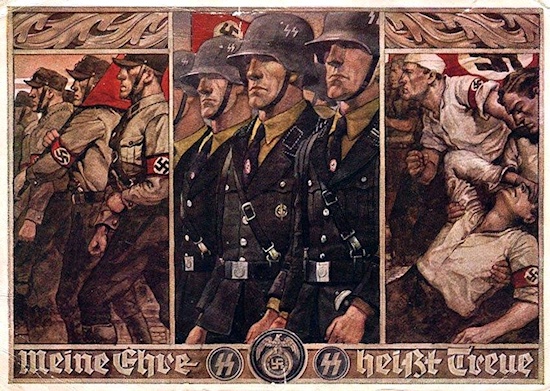
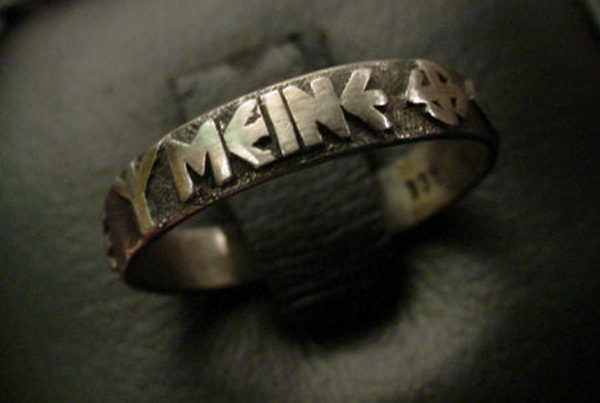
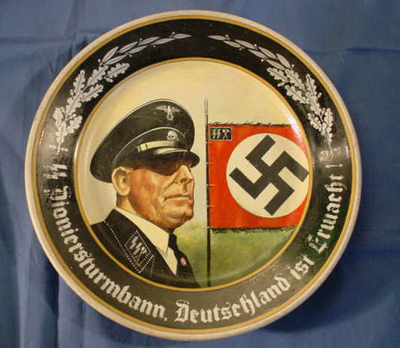


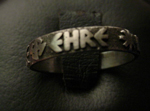
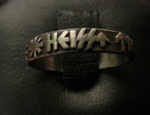
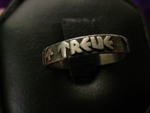
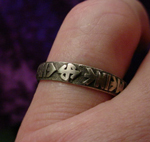
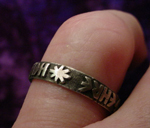
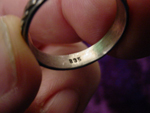
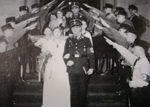
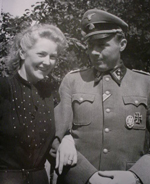
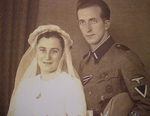
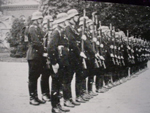
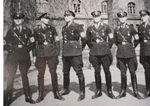
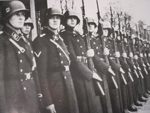
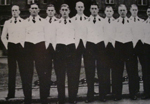
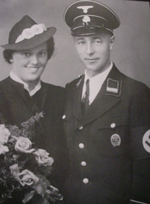

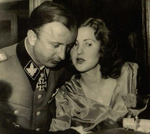





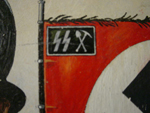
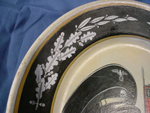
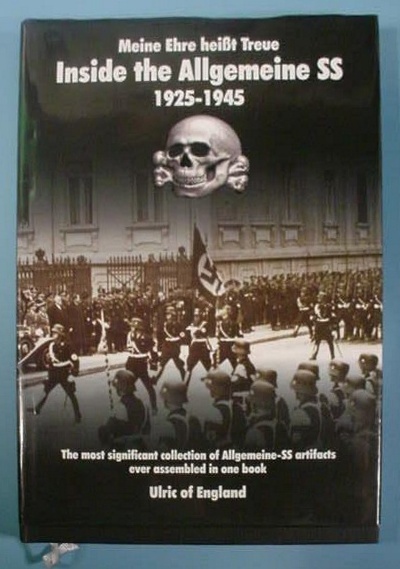
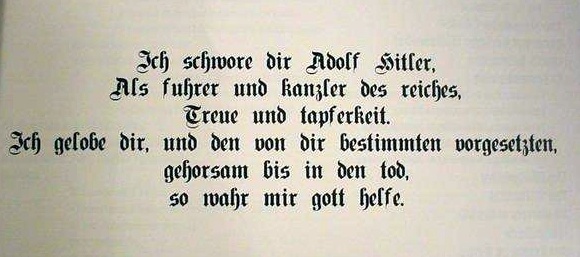
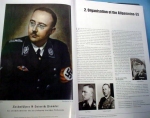
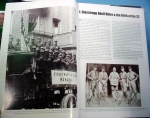
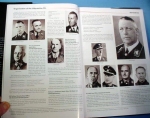
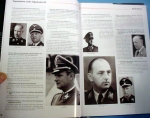
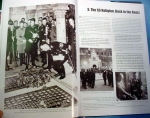
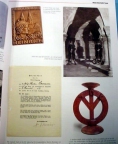
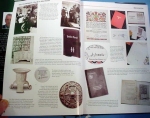
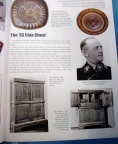
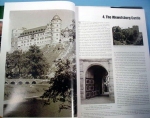
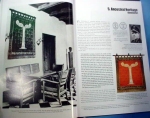
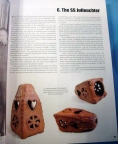
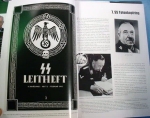
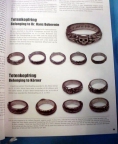
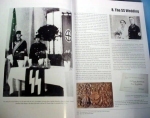
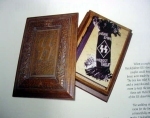
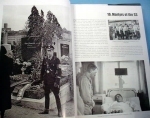
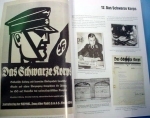
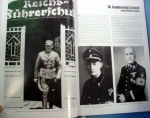
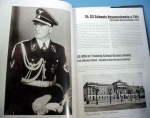
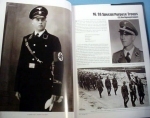
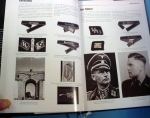
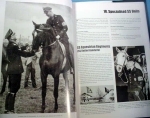
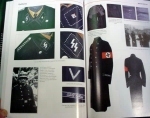
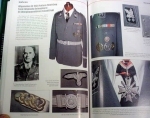
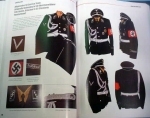
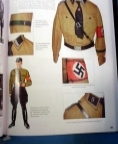
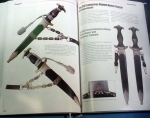
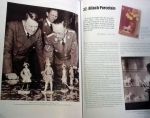
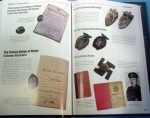
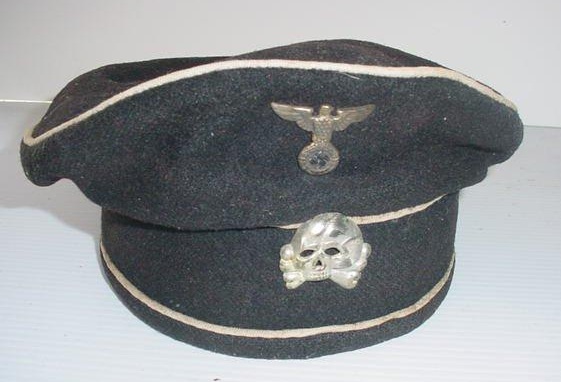
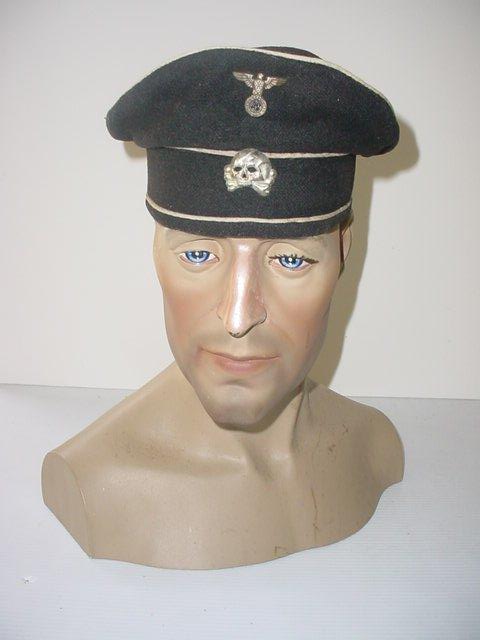
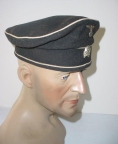
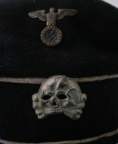
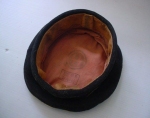

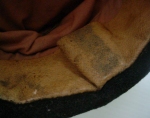
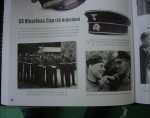

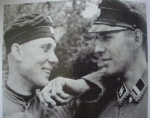
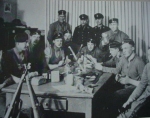
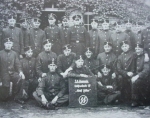
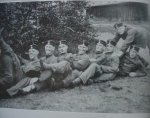
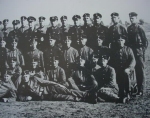
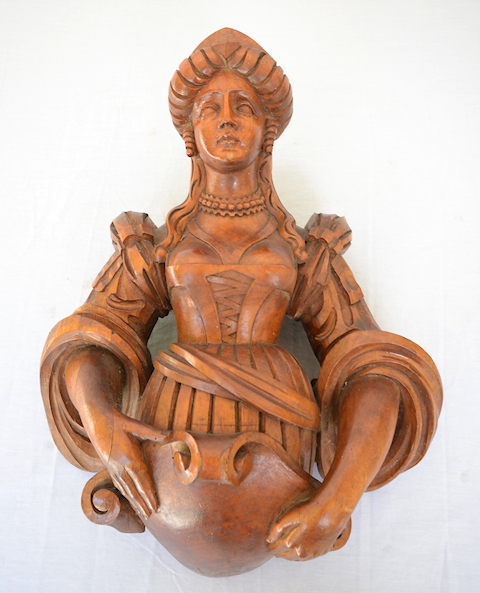
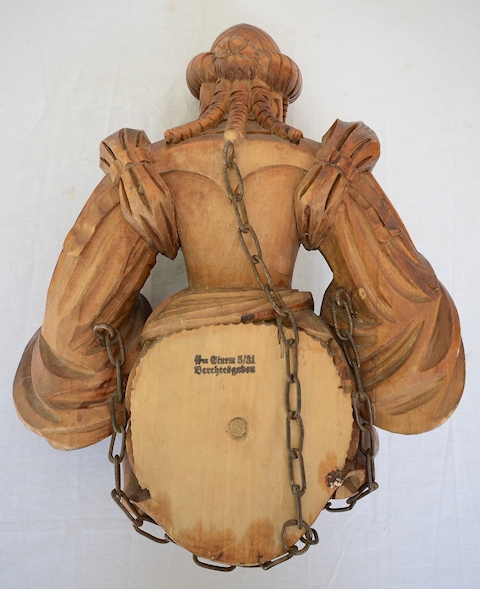






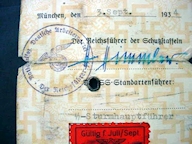
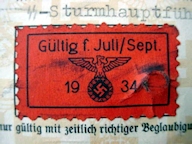
 Identification Card (Item SS 36-9)
Identification Card (Item SS 36-9)

